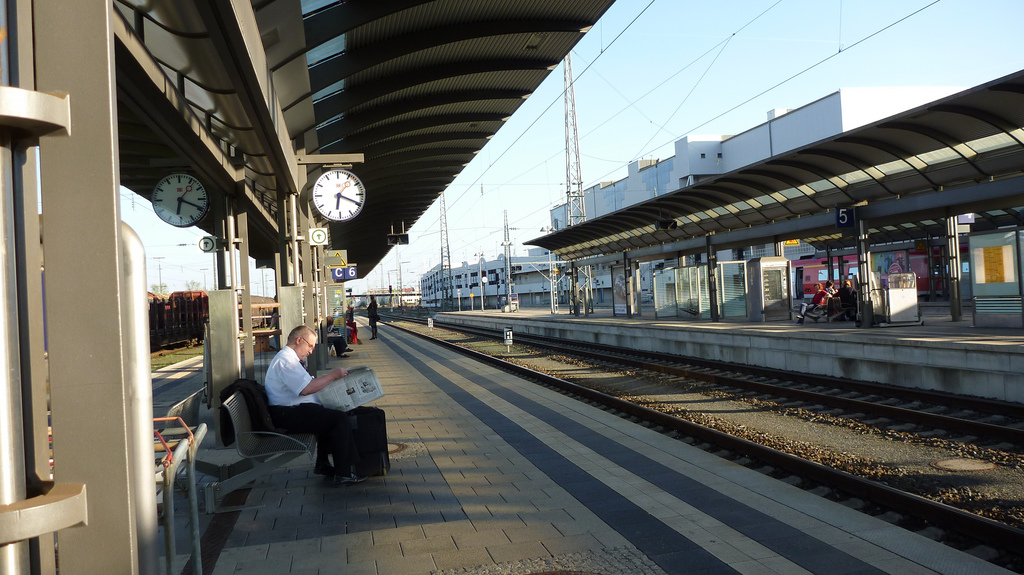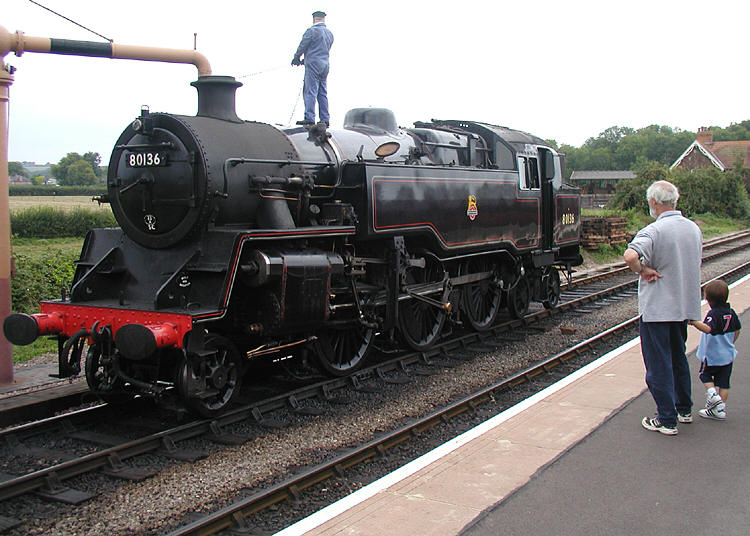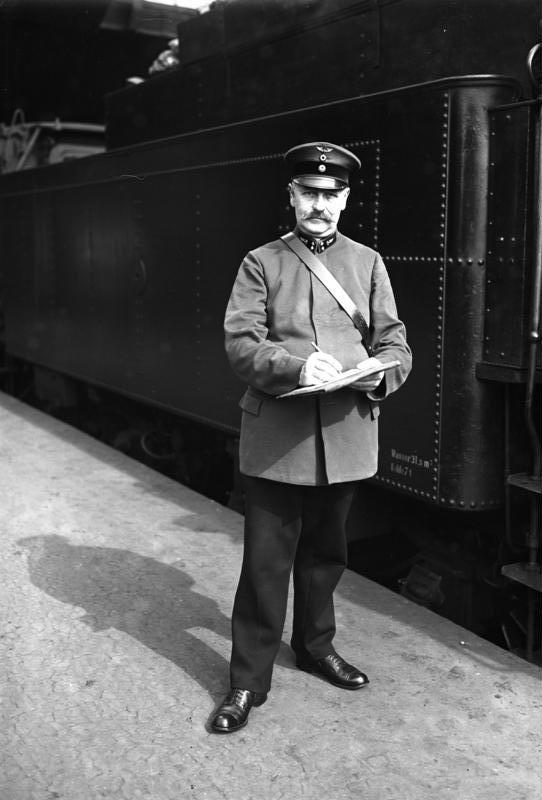|
Bamberg Station
Bamberg station is the only passenger station of the city of Bamberg in Upper Franconia in the German state of Bavaria. It is a major hub station for local trains operated by Deutsche Bahn and Agilis and is also a regularly served by Intercity-Express and Intercity trains. The station is on the Nuremberg–Bamberg, Bamberg–Hof and Bamberg–Rottendorf railway lines. It has seven platform tracks and is classified by Deutsche Bahn as a category 2 station. It is the northern terminus of line S1 of the Nuremberg S-Bahn. Location The station is located in eastern Bamberg, northeast of the Regnitz. On its perimeter are the streets of Ludwigstraße to the west, Starkenfeldstraße to the south, which crosses the rail tracks on a bridge, Brennerstraße to the east and Zollnerstraße to the north, which runs in an underpass under the tracks. Luitpoldstraße connects the inner city with Ludwigstraße opposite the station forecourt. The station building is located west of the r ... [...More Info...] [...Related Items...] OR: [Wikipedia] [Google] [Baidu] |
Friedrich Bürklein
Georg Friedrich Christian Bürklein (30 March 1813 – 4 December 1872) was a German architect and a pupil of Friedrich von Gärtner.Allgemeine Deutsche Biographie"Bürklein, Friedrich" (in German) Biography He was born in Burk, Middle Franconia. His first important work was the construction of the town hall in Fürth (1840–50) which is influenced by the Palazzo Vecchio in Florence. Bürklein created also the Hauptbahnhof in Munich (1847–1849) with its steel construction and the stations of Augsburg, Bamberg, Ansbach, Neu-Ulm, Hof, Nördlingen, Rosenheim, Würzburg, Nuremberg and Bad Kissingen. From 1851 Bürklein was the chief architect of the royal Maximilianstraße in Munich with all its state buildings including the Maximilianeum. Its Neo-Gothic architecture was influenced by the Perpendicular style and was strongly disputed. Before the Maximilianeum was finished Bürklein was replaced by Gottfried Semper. The sensitive Bürklein died mentally deranged in the sanatoriu ... [...More Info...] [...Related Items...] OR: [Wikipedia] [Google] [Baidu] |
S1 (Nuremberg S-Bahn)
The S1 is a service on the Nuremberg S-Bahn. It is long and runs from Bamberg via Erlangen, Fürth and Nuremberg to Hartmannshof. History The line opened on September 26th 1987 with initial service from Nuremberg main station to Lauf (links der Pegnitz). With the December 2010 schedule change, it was extended to Bamberg via Fürth and Erlangen. Upgrades and service extensions In the course of the VDE8 Nuremberg–Erfurt high-speed railway, the existing line between Bamberg and Nuremberg is extended to quadruple tracks. However, within the city boundaries of Fürth this planned upgrade ran into problems. As the original plans called for the two S-Bahn tracks to be laid east of the existing line to connect a (then planned but since scrapped) new industrial development between the cities of Nuremberg Fürth and Erlangen, the existing station of "Vach" would have lost passenger rail service and would have been replaced with two new stations called "Fürth Steinach" and "Fürth Stad ... [...More Info...] [...Related Items...] OR: [Wikipedia] [Google] [Baidu] |
Intercity (Deutsche Bahn)
Intercity is the second-highest train classification in Germany, after the ICE. Intercity services are loco-hauled express train services, usually over long-distances. There are Intercity routes throughout Germany, and routes generally operate with a two-hour frequency, with multiple routes giving a more frequent service on core routes. Intercity services are operated by the DB Fernverkehr sector of Deutsche Bahn. The ''Intercity'' name was introduced in Germany in 1971, replacing the old F-Zug category, and was the top category of train in Germany until the introduction of the ICEs in the early 1990s. With the proliferation of ICE services, the role of IC trains has diminished slightly, and they have taken on the character of many former InterRegio trains. Nonetheless, Intercity trains still offer a very high standard of speed and comfort – all services convey first class accommodation, and most include catering – usually a Bistro Cafe, but some services include a restau ... [...More Info...] [...Related Items...] OR: [Wikipedia] [Google] [Baidu] |
München Hauptbahnhof
München Hauptbahnhof or Munich Central Station is the main railway station in the city of Munich, Germany. It is one of the three stations with long-distance services in Munich, the others being Munich East station (''München Ost'') and Munich-Pasing station (''München-Pasing''). München Hauptbahnhof sees about 450,000 passengers a day, which puts it on par with other large stations in Germany, such as Hamburg Hauptbahnhof and Frankfurt (Main) Hauptbahnhof. It is classified by Deutsche Bahn as a category 1 station, one of 21 in Germany and two in Munich, the other being ''München Ost''. The mainline station is a terminal station with 32 platforms. The subterranean S-Bahn with 2 platforms and U-Bahn stations with 6 platforms are through stations. The first Munich station was built about to the west in 1839. A station at the current site was opened in 1849 and it has been rebuilt numerous times, including to replace the main station building, which was badly damaged during ... [...More Info...] [...Related Items...] OR: [Wikipedia] [Google] [Baidu] |
Berlin Hauptbahnhof
Berlin Hauptbahnhof () (English: Berlin Central Station) is the main railway station in Berlin, Germany. It came into full operation two days after a ceremonial opening on 26 May 2006. It is located on the site of the historic Lehrter Bahnhof, and on the Berlin S-Bahn suburban railway. The station is operated by DB Station&Service, a subsidiary of Deutsche Bahn AG, and is classified as a Category 1 station, one of 21 in Germany and four in Berlin, the others being Berlin Gesundbrunnen, Berlin Südkreuz and Berlin Ostbahnhof. ''Lehrter Bahnhof'' (Lehrte Station) opened in 1871 as the terminus of the railway linking Berlin with Lehrte, near Hanover, which later became Germany's most important east–west main line. In 1882, with the completion of the Stadtbahn (City Railway, Berlin's four-track central elevated railway line, which carries both local and main line services), just north of the station, a smaller interchange station called Lehrter Stadtbahnhof was opened to pro ... [...More Info...] [...Related Items...] OR: [Wikipedia] [Google] [Baidu] |
Cultural Heritage Management
Cultural heritage management (CHM) is the vocation and practice of managing cultural heritage. It is a branch of cultural resources management (CRM), although it also draws on the practices of cultural conservation, restoration, museology, archaeology, history and architecture. While the term cultural heritage is generally used in Europe, in the USA the term cultural resources is in more general use specifically referring to cultural ''heritage'' resources. CHM has traditionally been concerned with the identification, interpretation, maintenance, and preservation of significant cultural sites and physical heritage assets, although intangible aspects of heritage, such as traditional skills, cultures and languages are also considered. The subject typically receives most attention, and resources, in the face of threat, where the focus is often upon rescue or salvage archaeology. Possible threats include urban development, large-scale agriculture, mining activity, looting, eros ... [...More Info...] [...Related Items...] OR: [Wikipedia] [Google] [Baidu] |
Platform Display
A platform display, destination display or train describer (British English) is supplementing the destination sign on arriving trains giving passengers an advance information. Historically they did only show the next destination and sometimes the type of train. In later usage they were replaced by passenger information display systems (PIDS) allowing for real-time passenger information. The first railway stations had only a time table for passenger information. On larger stations the train porters would help passengers to board the correct train matching with their ticket. They were supervised by a station manager The station master (or stationmaster) is the person in charge of a railway station, particularly in the United Kingdom and many other countries outside North America. In the United Kingdom, where the term originated, it is now largely historical ... that would handle the security requirements for each departing train. The first help in that task was a bell to remin ... [...More Info...] [...Related Items...] OR: [Wikipedia] [Google] [Baidu] |
Munich Hauptbahnhof
Munich ( ; german: München ; bar, Minga ) is the capital and most populous city of the German state of Bavaria. With a population of 1,558,395 inhabitants as of 31 July 2020, it is the third-largest city in Germany, after Berlin and Hamburg, and thus the largest which does not constitute its own state, as well as the 11th-largest city in the European Union. The city's metropolitan region is home to 6 million people. Straddling the banks of the River Isar (a tributary of the Danube) north of the Bavarian Alps, Munich is the seat of the Bavarian administrative region of Upper Bavaria, while being the most densely populated municipality in Germany (4,500 people per km2). Munich is the second-largest city in the Bavarian dialect area, after the Austrian capital of Vienna. The city was first mentioned in 1158. Catholic Munich strongly resisted the Reformation and was a political point of divergence during the resulting Thirty Years' War, but remained physically unto ... [...More Info...] [...Related Items...] OR: [Wikipedia] [Google] [Baidu] |
Berlin
Berlin is Capital of Germany, the capital and largest city of Germany, both by area and List of cities in Germany by population, by population. Its more than 3.85 million inhabitants make it the European Union's List of cities in the European Union by population within city limits, most populous city, as measured by population within city limits having gained this status after the United Kingdom's, and thus London's, Brexit, departure from the European Union. Simultaneously, the city is one of the states of Germany, and is the List of German states by area, third smallest state in the country in terms of area. Berlin is surrounded by the state of Brandenburg, and Brandenburg's capital Potsdam is nearby. The urban area of Berlin has a population of over 4.5 million and is therefore the most populous urban area in Germany. The Berlin/Brandenburg Metropolitan Region, Berlin-Brandenburg capital region has around 6.2 million inhabitants and is Germany's second-largest metropolitan reg ... [...More Info...] [...Related Items...] OR: [Wikipedia] [Google] [Baidu] |
Nürnberg Hauptbahnhof
Nürnberg Hauptbahnhof (German for ''Nuremberg main station'') or Nuremberg Central Station''The train to the plane'' at www.lufthansa.com. Accessed on 7 Oct 2013 at www.dbmuseum.de. Accessed on 7 Oct 2013 is the main railway station serving the city of in . It is the largest station in north |
Deutsche Reichsbahn
The ''Deutsche Reichsbahn'', also known as the German National Railway, the German State Railway, German Reich Railway, and the German Imperial Railway, was the German national railway system created after the end of World War I from the regional railways of the individual states of the German Empire. The ''Deutsche Reichsbahn'' has been described as "the largest enterprise in the capitalist world in the years between 1920 and 1932"; nevertheless its importance "arises primarily from the fact that the Reichsbahn was at the center of events in a period of great turmoil in German history". Overview The company was founded on 1 April 1920 as the ("German Imperial Railways") when the Weimar Republic, which still used the nation-state term of the previous monarchy, (German Reich, hence the usage of the in the name of the railway; the monarchical term was ), took national control of the German railways, which had previously been run by the German states. In 1924 it was reorgan ... [...More Info...] [...Related Items...] OR: [Wikipedia] [Google] [Baidu] |
Hof Hauptbahnhof
Hof Hauptbahnhof (German for ''Hof main station''; sometimes translated as "Hof Central Station" or described as "Hof central station" in English) is the main railway station in Hof in southern Germany and is situated at the intersection of the Saxon-Franconian trunk line (''Magistrale'') and the Munich–Regensburg–Leipzig–Berlin line. When it was opened it formed the boundary between the former Bavarian Ludwig South-North Railway Lindau– Hof to the Saxon-Bavarian Railway on the Saxon side from Hof–Leipzig. Today the Deutsche Bahn has classified Hof Hauptbahnhof as category 3 – a regional hub/long-distance stop. Lines and services The Regensburg–Hof, Bamberg–Hof and Leipzig–Hof main lines all meet at Hof Hauptbahnhof, as does the Hof–Bad Steben branch line. History After the old Hof station north of the city centre was no longer able to handle the growth in traffic, the Bavarian and Saxon railway administrations built a common, large-scale, through ... [...More Info...] [...Related Items...] OR: [Wikipedia] [Google] [Baidu] |


.jpg)




